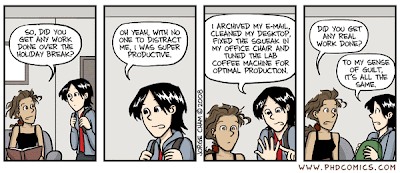Today we talk about nuclear power, it's physics and it's uses. First up to bat, fission.
At it's most simplistic, the difference between fission and fusion is that fission it when the nucleus of an atom splits, and fusion is where two nuclei, funnily enough, fuse, join together. Alas, simplistic isn't what we really want here so let's delve a little deeper.
It is possible for fission to occur without our intervention, however this is pretty rare, and not so helpful in regards to our power. So, we are forced to split our nuclei ourselves, and we go about this in the most obvious way. We bombard them with neutrons.
Ideally you'll remember all the work that was done regarding the discovery of the nucleus. Maybe you'll also have an idea of the work on radiation done by the Curies and Becquerel, and of course Einstein's foray into mass-energy equivalence. Basically, the early 20th Century was a good time to be into physics, as we began to understand more and more about the subatomic world. So much so in fact, that some thought we might try breaking back into that old alchemical pastime of transmutation that the ancients and the people of the middle-ages seemed to have so much trouble with. In 1917 Rutherford managed to transmute Nitrogen into Oxygen. Not quite Lead into Gold, I'll grant you, but still pretty ground breaking, I think you'll agree. He achieved this by directing alpha particles into Nitrogen:
14N + α →
17O + p.
Eventually the neutron was discovered and a fellow called Enrico Fermi had the bright idea to fire them at uranium, the heaviest natural element, in order to create a new, heavier element. confident with his work, he named the new element Hesperium. Others however were not so convinced. A German chemist suggested that instead of becoming a bigger atom, it was conceivable that it broke down into smaller chunks. This line of thought however was not pursued.
Not until a group of physicists started performing similar experiments in Berlin. Otto Hahn, Lise Meitner, and Fritz Strassmann (The textbook doesn't mention Meitner, which I think is kind of unfair given that even though she continued to collaberate by mail, the only reason she wasn't a part of some of the work is because she was fleeing, well, she was an Austrian Jew in 1938. Work it out. Anyway...) found that after bombardment that sure enough the product was not a larger element, but Barium, an element with 40% less mass than Uranium. In the words of Meitner's nephew Otto Robert Frisch:
Was it a mistake? No, said Lise Meitner; Hahn was too good a chemist for that. But how could barium be formed from uranium? No larger fragments than protons or helium nuclei (alpha particles) had ever been chipped away from nuclei, and to chip off a large number not nearly enough energy was available. Nor was it possible that the uranium nucleus could have been cleaved right across. A nucleus was not like a brittle solid that can be cleaved or broken; George Gamow had suggested early on, and Bohr had given good arguments that a nucleus was much more like a liquid drop. Perhaps a drop could divide itself into two smaller drops in a more gradual manner, by first becoming elongated, then constricted, and finally being torn rather than broken in two? We knew that there were strong forces that would resist such a process, just as the surface tension of an ordinary liquid drop tends to resist its division into two smaller ones. But nuclei differed from ordinary drops in one important way: they were electrically charged, and that was known to counteract the surface tension.
The charge of a uranium nucleus, we found, was indeed large enough to overcome the effect of the surface tension almost completely; so the uranium nucleus might indeed resemble a very wobbly unstable drop, ready to divide itself at the slightest provocation, such as the impact of a single neutron. But there was another problem. After separation, the two drops would be driven apart by their mutual electric repulsion and would acquire high speed and hence a very large energy, about 200 MeV in all; where could that energy come from? ...Lise Meitner... worked out that the two nuclei formed by the division of a uranium nucleus together would be lighter than the original uranium nucleus by about one-fifth the mass of a proton. Now whenever mass disappears energy is created, according to Einstein's formula E=mc2, and one-fifth of a proton mass was just equivalent to 200MeV. So here was the source for that energy; it all fitted!
To make a long quote short, they concluded that the Uranium has more or less split down the middle. Actually, I really like that liquid drop analogy. That makes things much easier to visualise. To hell with you textbook.
 |
| Smug wanker. |
Anyway, back to the physics. As well as the two chunks of smaller atom, it was found that 2-3 separate neutrons were also released in the division. So consider this. You have a bunch of
235U that you fire a neutron at. This bothers one of the
235Us enough to make it split, producing Barium and Krypton or whatever, a chunk of energy, and 3 shiny new neutrons. Neutrons released into the very same bunch of
235U. Yeah. Suddenly you have a whole bunch of other neutrons colliding with yet more
235U, and I think you probably get it. There is a whole lot of energy being released. This, friends, is a nuclear chain reaction.
As for how the energy is released, when the
235U undergoes fission, the two new chunks, both being positively charged, repel each other, sufficiently so that they overcome the strong interaction holding them together. From this they gain kinetic energy. Being smaller, they are more stable, having more binding energy that the original nucleus. The change of this binding energy is equal to the energy released, which is in the order of 200 MeV.
Alright, so now we know what fission is about, lets get on to fusion. This is the energy source that will solve all global problems, end strife and provide cheap energy for all! Or not, but it'd be pretty damn useful, if only we could get it working properly and reliably. Indeed, the only consistently reliable fusion power source we currently have is the Sun.
Fusion, being the cousin of fission, also involves one particle at one end with two at the other, only this time it is the two particles coming together to make one larger one. Now, you have to remember that the electrostatic repulsion is what gives the two resultant fission particles such a high resultant kinetic energy. It's this same force that needs to be overcome to force the two smaller particles close enough to let the strong interaction take over.
This is all a roundabout way to get you to the maths of it all, which you already know if you think back to part one. Yeah, when you get two particles together the change in binding energy is found as a change in mass. This mass can get you the energy released in the fusion event. Pretty basic stuff as long as you get the maths right.
The more interesting aspect, other than the infinite energy and everlasting peace on earth is the sun. The sun is incomprehensibly hot. Consider that the very centre of our dear Earth , the solid inner core is thought to be roughly 5700 K. This is nearabouts the temperature of the sun's
surface. The core, where all the fusion fun happens is closer to 15000000 K
1. At this kind of temperature atoms are kind of like "Bloody hell it's hot", take off their nice electron cloaks, and go for a casual, high energy jog. You might expect hat this would cause them to collide at high speeds, and, well, you'd be right. Such high energies in fact that lo and behold, they overcome electrostatic repulsion and undergo fusion. This is the start of a process known as a
proton-proton chain reaction.
The only other thing you really need to know about fusion right now is that we're trying to get it working down here. Really we are, and have been for over 50 years, but it just wasn't sticking until recently. There are however some decent prototypes in the making, including JET, the Joint European Torus, which has shut down now but paved the way for ITER, International Thermonuclear Experimental Reactor, which in turn has sparked planned to built the DEMOnstration Power Plant which will build on ITERs results. That's a planned project inspired by the
projected success of a project that hasn't even properly started yet. That's some comforting confidence, right? Should all this pan out, it may lead to PROTO, the world's first
commercial fusion power plant. I am genuinely excited about this, guys. Science fiction future here we come!
1Incidentally, if you're using the AQA Physics A textbook, it tells you that the temperature is 10
8. Clearly this is wrong, by an entire factor of 10. Seriously, fuck this book.





















